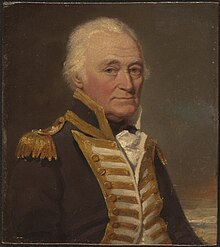John Hunter (Royal Navy officer)
| John Hunter | |
|---|---|
 |
|
| 2nd Governor of New South Wales | |
|
In office 11 September 1795 – 28 September 1800 |
|
| Preceded by | Arthur Phillip |
| Succeeded by | Philip Gidley King |
| Personal details | |
| Born |
29 August 1737 Leith, Scotland |
| Died | 13 March 1821 (aged 83) Judd Street, New Road, Hackney, London |
| Resting place | Church of St John-at-Hackney |
| Military service | |
| Allegiance |
|
| Service/branch | Royal Navy |
| Rank | Vice-Admiral |
| Commands |
|
| Battles/wars | Napoleonic Wars |
Vice Admiral John Hunter (29 August 1737 – 13 March 1821) was an officer of the Royal Navy, who succeeded Arthur Phillip as the second governor of New South Wales, Australia and served as such from 1795 to 1800.
Both a sailor and a scholar, he explored the Parramatta River as early as 1788, and was the first to surmise that Tasmania might be an island. As governor, he tried to combat serious abuses by the military in the face of powerful local interests led by John MacArthur. Hunter's name is commemorated in historic locations such as Hunter Valley and Hunter Street, Sydney.
John Hunter was born in Leith, Scotland, the son of William Hunter, a captain in the merchant service, and Helen, née Drummond, daughter of J. Drummond and niece of George Drummond, several-time lord provost of Edinburgh. As a boy Hunter was sent to live with an uncle in the town of Lynn in Norfolk, where, and also at Edinburgh, he received the classical education of the time. Hunter was sent to University of Edinburgh, but soon left it to join the navy as a captain's servant to Thomas Knackston in HMS Grampus in May 1754. In 1755 he was enrolled as able seaman on HMS Centaur, became a midshipman and served on HMS Union and then HMS Neptune. While aboard Neptune he was present at the Raid on Rochefort in 1757, and afterwards served during cruises off Brest in 1758 and the capture of Quebec in 1759. Serving aboard Neptune at this time as her first lieutenant was John Jervis, who became an acquaintance of Hunter.
...
Wikipedia
